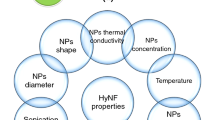Abstract
In the present study, the hydrodynamic characteristics of a pump-jet were numerically investigated using an incompressible RANS flow solver based on pseudo-compressibility. The focus of the study is the assessment of the flow characteristics and performance, particularly of a ring rotor with the rotor blades interconnected with a circumferential ring at the tip. For this purpose, a vertex-centered finite- volume method on unstructured meshes was used in conjunction with second-order Roe’s FDS to discretize the inviscid fluxes, while the viscous fluxes were computed based on central differencing. For the unsteady time integration, a dual-time stepping method and the Gauss-Seidel iteration were employed. An unstructured overset mesh technique was adopted to treat the relative motion between the rotor and the main body of the pump-jet. For the closure of turbulence, the Spalart-Allmaras one equation model was employed. To validate the flow solver, the calculations were initially made for the High Reynolds number pump (HIREP) configuration at several advancing ratios. Reasonable agreements were obtained between the present results and the experiment in terms of the pressure coefficient on the blade surface, velocity distribution, and integrated blade loadings. To investigate the effect of the ring on the flow characteristics and propulsion performance of the pump-jet, additional calculations were made for the HIREP configuration installed with the circumferential ring at the rotor blade tip, and the results were compared with those of the original HIREP configuration. The addition of the ring at the blade tip helped reduce the tip vortex strength, which might be beneficial in suppressing the formation of water vapor. Furthermore, the cavitation performance on the suction surface of the rotor blades was degraded by the reduced axial velocity because of the passage area reduction after the ring was attached. With the addition of the ring, the blade loadings of the pump-jet, such as the thrust and torque, were reduced even though the efficiency, defined as the ratio of thrust and torque, was maintained.
Similar content being viewed by others
References
O. Furuya and W. L. Chiang, A new pumpjet design theory, DTIC Report No. N00014-85-C-0050 (1988).
W. C. Zierke, W. A. Straka and P. D. Taylor, An experimental investigation of the flow through an axial flow pump, Journal of Fluids Engineering, 117 3 1993 485–490.
J. J. Dreyer and W. C. Zierke, Solution of the averagedpassage equations for the incompressible flow through multiple-blade-row turbomachinery, The Pennsylvania State University, Applied Research Laboratory Technical Reports No. TR 94-05 (1994).
C. I. Yang, A simulation of viscous incompressible flow through a multiple-blade-row turbomachinery with a highresolution upwind finite-differencing scheme, Numerical Simulation in Turbomachinery, 227 1995 11–18.
W. S. Yu, B. Lakshminarayana and D. E. Thompson, Computation of three-dimensional viscous flow in high Reynolds number pump guide vane, Journal of Fluids Engineering, 118 3 1996 698–705.
Y. T. Lee, C. Hah and J. Loellbach, Flow analysis in a single-stage propulsion pump, Journal of Turbomachinery, 118 2 1996 240–248.
P. L. Vosfer and A. J. Brown, Pumpjet propulsion — a British splendid achievement, Journal of Naval Engineering, 36 (2) (1996).
H. N. Das, P. Jayakumar and V. F. Saji, CFD examination of interaction of flow on high speed submerged body with pump-jet propulsor, 5th International Conference on High Performance Marine vehicles, Australia, 8–10 Nov. (2006).
C. H. Suryanarayana, B. Satyanarayana, K. Ramji and A. Saiju, Experimental evaluation of pumpjet propulsor for an axisymmetric body in wind tunnel, International Journal of Naval Architecture and Ocean Engineering, 2 1 2010 24–33.
S. Ivanell, Hydrodynamic simulation of a torpedo with pumpjet propulsion system, Master Thesis, Royal Institute of Technology, Stockholm, Sweden (2011).
H. K. Lee, E. D. Park, K. K. Shin, C. K. Kim and K. C. Lee, Ring rotor-type pump-jet propulsion device of underwater moving mass, Korean Patent 1020040026906 (2004).
M. S. Jung and O. J. Kwon, A parallel unstructured hybrid overset mesh technique for unsteady viscous flow simulations, International Conference on Parallel Computational Fluid Dynamics, Antalya, Turkey (2007).
A. J. Chorin, A numerical method for solving incompressible viscous flow problems, Journal of Computational Physics, 2 12 1967 12–26.
P. L. Roe, Approximate Riemann solvers, parameter vectors and difference scheme, Journal of Computational Physics, 43 1981 357–372.
P. R. Spalart and S. R. Allmaras, A one-equation turbulence model for aerodynamic flows, AIAA paper-92-0439 (1992).
Author information
Authors and Affiliations
Corresponding author
Additional information
Recommended by Associate Editor Seongwon Kang
Sang Jun Ahn is a Ph.D. student at the Computational Aerodynamics and Design Optimization Laboratory in the Department of Aerospace Engineering, KAIST, Korea. His research interests are computational simulations and design optimizations for multi-phase flow problems.
Oh Joon Kwon is a professor at the Department of Aerospace Engineering, KAIST, Korea. His research interests are computational algorithm development and numerical simulation based on unstructured meshes for a variety of applied aerospace problems.
Rights and permissions
About this article
Cite this article
Ahn, S.J., Kwon, O.J. Numerical investigation of a pump-jet with ring rotor using an unstructured mesh technique. J Mech Sci Technol 29, 2897–2904 (2015). https://doi.org/10.1007/s12206-015-0619-7
Received:
Revised:
Accepted:
Published:
Issue Date:
DOI: https://doi.org/10.1007/s12206-015-0619-7




